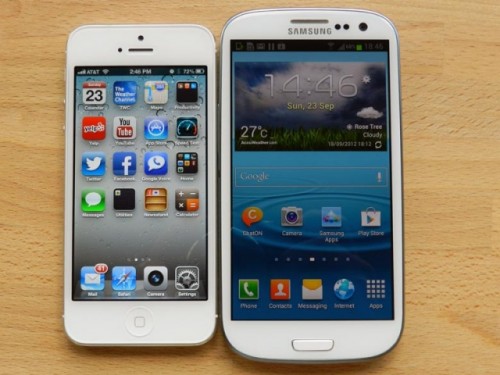We all know that it is an Apple & Samsung world – and pretty much everywhere I go I carry both my Apple iPhone 5 and Samsung Galaxy S3. They are both excellent phones, and I highly recommend both of them to anyone looking for a phone – each has strengths and weaknesses, just like any other device. Don’t believe the hype whenever someone tells you one is ‘far superior’ to the other: it simply meets their personal needs better. Recently my work has required me to be at a remote manufacturing facility where there is no cell phone signal but there is WiFi. I set up both phones to use WiFi and by the end of the day I found another way iPhone beats Android – battery life in the dungeon!
Most older tech lovers remember before businesses had repeaters and amplifiers to deal with the massive signal degradation caused by concrete and steel – I remember having to shut off phones before entering our wafer fab building otherwise the phone would be hot and dead in a few hours. That same ‘signal hunting’ goes on now even with smartphones, and if you are in a no-signal zone for too long your phone will end up running through the battery. That is simply because phones REALLY want a signal lock and will desperately expend power trying to find and lock on a signal.
But more recently smartphones have allowed users to link up to WiFi networks. This allows for faster data transfer (in some cases), and it doesn’t use up your precious data allocation. Most smartphone users spend upwards of 90% of their time ion WiFi coverage, and smartphone makers have increasingly allowed functionality over WiFi that was previously reserved for cell data – in particular messaging.
But the question it – how should a smartphone manage power in an area of abundant WiFi but no cell coverage?
Turns out that iOS and Android have different answers! During my very first trip I discovered that while the iPhone battery lasts all day long, the Galaxy S3 will generally be totally dead by lunch – and these phones would normally have more or less equal battery life! My iPhone is my primary device, meaning I am using it all day long; the Galaxy S3 will sometimes sit in my bag most of the day.
To test it further I set up an experiment: since I have the same email accounts, Twitter, Facebook and so on installed on both devices, it was easy to partition what I looked at and where. What I did was only let myself check my phone every 30 minutes (unless a text came in), and alternated email and social media and RSS between the phones. I did this every day for a week (5 days).
The results?
– By lunch time (I had been at the plant ~4-5 hours) each day the iPhone still have >80% battery, whereas the Galaxy S3 had <10%.
– By the end of the day (we are doing ~12-13 hour days) the iPhone had >50% and the Galaxy S3 was long since dead.
– The last two days I plugged the Galaxy S3 into the PowerStick+ just after lunch to keep it on life support … and on both days by the time I left the PowerStick+ was nearly drained and the Galaxy S3 had ~20-25% battery remaining.
So there it is – Apple has figured out a way to keep your battery alive when you are totally out of cell signal range … and Samsung just keeps draining the battery in hopes that cell signal will come along and save it. This is not a normal use case, far from it – most people are around at least decent cell signal a lot of the time. But if you know you will be in a dead zone, this is one more bit of data to help you decide what phone is right for you.
